Safety first – well protected with guard columns
Guard columns in chromatography protect the analytical separation column. Will they affect the separation?
Guard columns are familiar to anyone working in chromatography, but they are by no means used in every analysis. This article explains guard columns and their function as well as the advantages and disadvantages.
A guard column is a typical consumable. It is installed in front of the main column and protects it from impurities that can come from the sample, matrix or eluent by collecting and trapping particles and/or irreversibly binding substances. It extends the lifecycle of the more expensive main column and, being the cheaper component, is replaced more often.
Function of a guard column
The guard column is smaller than the main column and is usually equipped with the same packing material. In the best case, particle sizes of the guard and main columns are identical. The inner diameter of the column and the size of the frit should be equal or smaller, and the pressure specifications of the guard column should match those of the main column.
Anyone who has ever changed the filter at the top of the column is aware of the impurities that often accumulate there. Contaminations may origin from the sample or sample matrix. The guard column traps them in front of the main column with various protective measures: [1]
- Chemical protection: If the matrix or sample are particularly aggressive, they may react with the column material. In this case, provided the guard column is made of the same material as the separation column, most substances react with the guard column and the analytical column is protected.
- Particle trap: If the guard column has the same porosity as the analytical column, any particles larger than the frit are trapped by the guard column before they reach the analytical column where they get caught and block it.
- Other polarities: Analytes with different polarities can adhere to the packing material of the guard column and interact so strongly that they remain irreversibly bound to the stationary phase (of the guard column) and accumulate.
So-called in-line filters trap larger molecules and are the cheapest option to protect the separation column [1]. However, they only work physically and not chemically. The filling material is a filter with a specific porosity. Compared with the column, it should be slightly smaller so that the inline filter captures particles before they enter the column. As soon as system pressure starts to rise, it’s time to swap the inline filter, as the increase in pressure indicates that the filter is blocked with particles. Compared to the guard column, its replacement is quicker, as is the subsequent system conditioning.
Influence of a guard column on the separation
When adding a guard column, an increase in the plate number N would be expected, because with the additional guard column, the system, contains more stationary phase. However, this effect is mostly lost by the fact that more dead volume is created in the system when installing a guard column. If the capillaries used to connect the guard column are too long, this effect may even adversely affect the chromatogram. [2]
A guard column behaves like an extra piece of separation column, so when in use, it always increases the system pressure. For these reasons, it should be as short as possible (often 1 – 5 cm, typically 0.5 – 2 cm) to avoid increase in system pressure and to minimally influence the chromatographic separation. [1] The effects of guard columns on chromatographic separation are examined below by assessing different column types with and without the associated guard column.
Changing the guard column
Many users are unsure of when a guard column should be replaced. There are several indications of the need for change. When the system pressure increases, this is a sign that particles have accumulated and are slowly clogging it.
Another indication may be a decreasing number of plates or a change in the signal. Alternatively, the user may specify a certain maximum number of injections. As a rule of thumb, the guard column is changed approximately three times during the service life of the main column.
Types of guard columns
There are different types of guard columns:
- packed guard columns – these are simply „mini-variants“ of the analytical columns
- the „cartridge type“ – here, small cartridges are placed in a holder and can be installed in front of the column.
Shimadzu’s Shim-pack range includes both types; they are explained in the following section.
Guard column types in the Shim-pack portfolio
The LC Column range offers a choice of different types of guard columns to fit different LC columns. The most important series with the associated guard columns are shown in table 1.
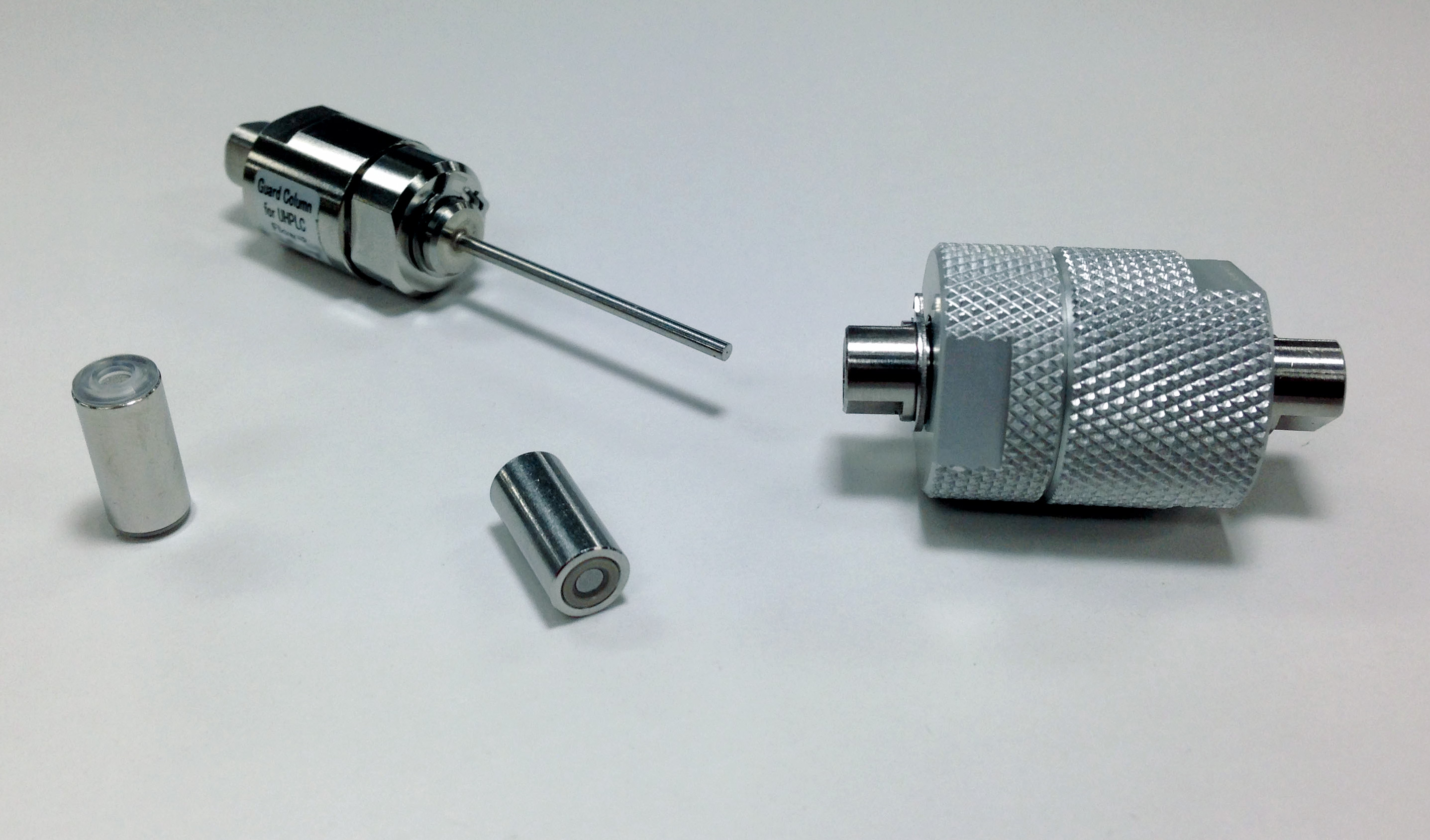 Figure 1: G-series holder (high pressure and conventional type) with cartridges
Figure 1: G-series holder (high pressure and conventional type) with cartridges
 Table 1: Column types in the Shim-pack assortment with corresponding guard column type
Table 1: Column types in the Shim-pack assortment with corresponding guard column type
The guard column holders and cartridges of the Shim-pack G-series (figure 1) are available as a high-pressure version (holder in the top of the picture) and in a conventional version (holder in the bottom of the picture). The former is pressure stable up to 800 bar, whereas the conventional version is compatible for analyzes up to 200 bar. The high-pressure guard column can be installed with an additional fitting. For the conventional guard column, a short capillary with two fittings is needed as a connecting piece.
The Velox core shell series guard columns are used in the same way. The guard column cartridge is mounted in a holder and then installed in front of the column. The schematic principle is shown in figure 2 and the assembled guard column is shown in figure 3. This guard column can be installed directly in the system without additional fittings. In addition, a built-in spring provides safe installation with minimal dead volume.
 Figure 2: Schematic structure of the Velox guard column
Figure 2: Schematic structure of the Velox guard column
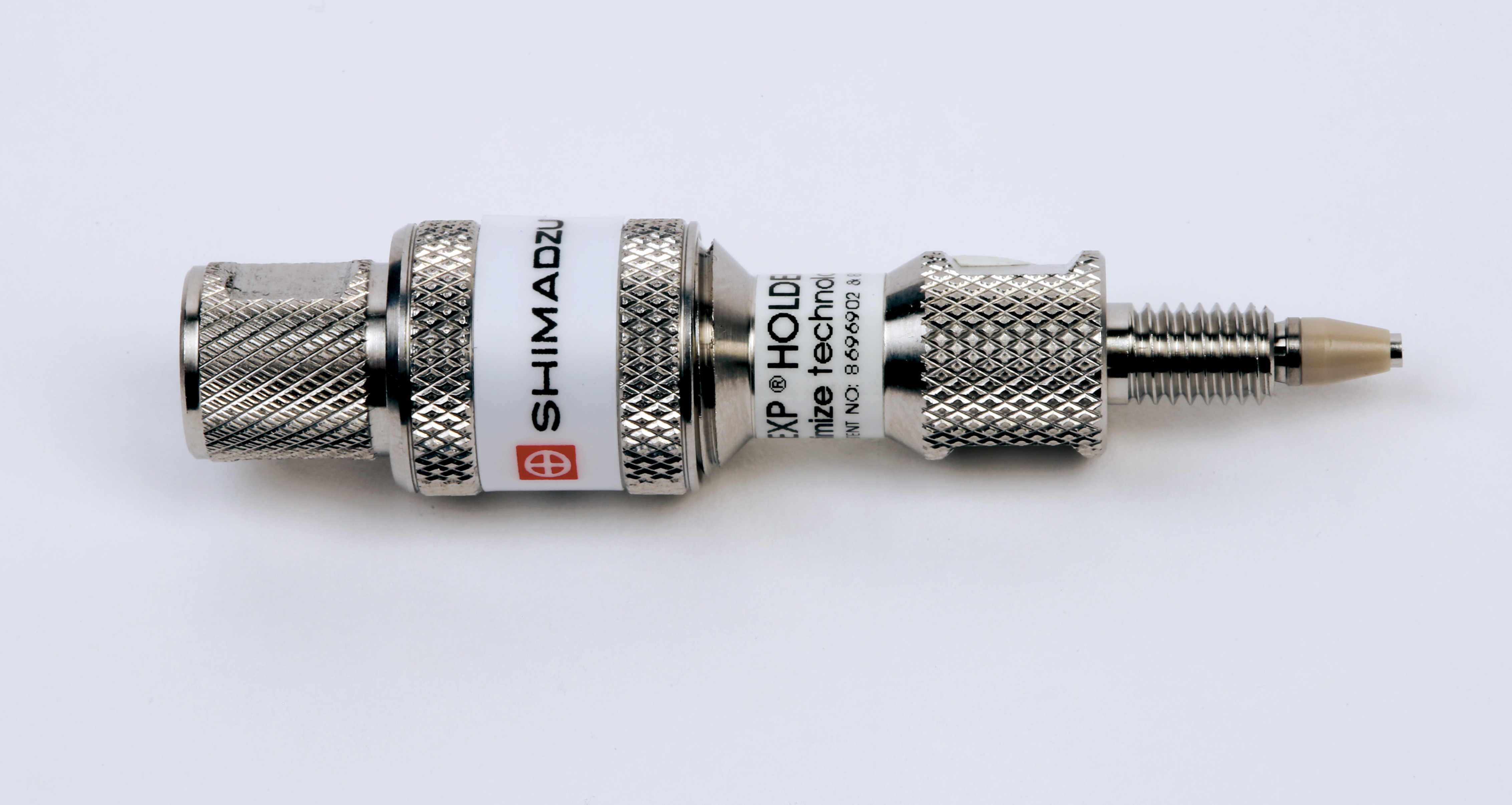 Figure 3: Velox guard column
Figure 3: Velox guard column
With the introduction of the Shim-pack Velox columns in autumn 2018, the Shim-pack Velox UHPLC precolumn filters have also been added to the range (figure 4). They do not contain a stationary phase but a porous material (0.2 µm), so they act purely physically and trap too large particles before they reach the main column. The guard column filter replaces or supports sample preparation with syringe filters.
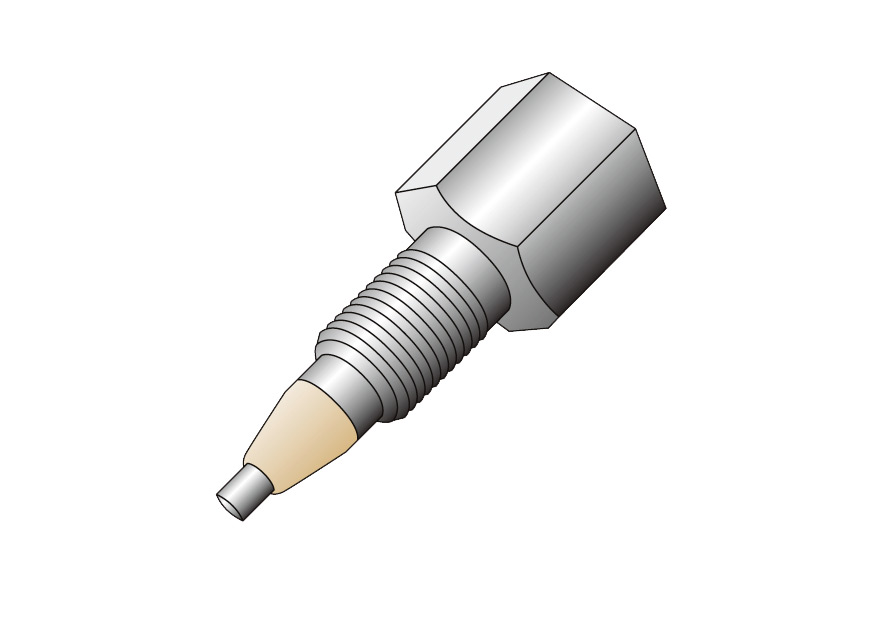 Figure 4: Velox precolumn filter
Figure 4: Velox precolumn filter
The ideal guard column would in no way affect chromatographic separation and would not change the system pressure. The next part of the experiment investigates how the various Shim-pack guard columns affect the chromatograms.
Measurement parameters and methods
Instruments: LC-2040C 3D (Shimadzu)
Column: Shim-pack GISS C18-HP (100 mm x 2.1 mm I.D., 1.9 µm); Guard column: Shim-pack GISS C18-HP (10 mm x 2.1 mm I.D., 1.9 µm)
Column: Shim-pack GIST C18 (100 mm x 2.1 mm I.D., 3.0 µm); Guard column: Shim-pack GIST C18 (10 mm x 1.5 mm I.D., 3.0 µm)
Column: Shim-pack XR-ODS II (75 mm x 2.0 mm I.D., 2.2 µm); Guard column: Shim-pack GISS C18-HP (10 mm x 2.1 mm I.D., 1.9 µm)
Column: Shim-pack Velox SP-C18 (100 mm x 2.1 mm I.D., 2.7 µm); Guard column: Shim-pack Velox EXP SP-C18 (5 mm x 2.1 mm I.D., 2.7 µm)
Mobile Phase: 35 % H2O; 65 % ACN
Sample: Uracil (20 µg/mL), methyl benzoate (220 µg/mL), toluene (860 µg/mL), naphthalene (200 µg/mL), dissolved in the eluent
Oven temperature: 40 °C
Flow rate: 0.4 mL/min, 0.2 mL/ min for the GIST C18 (100 mm x 2.1 mm I.D., 3.0 µm);
Injection volume: 0.5 und 1.0 µL
Results
In the following results and values of the chromatogram, the last eluting peak (naphthalene) is always taken as a comparison since the influence of changes is greatest here. The chromatograms show that guard columns have a slight influence on measurement results. If guard and main columns match, overall measurement results will be less affected than when using guard columns with main columns of a different type.
Columns and guard columns of the Shim-pack G-series
Tables 2 and 3 and figures 5 and 6 show the examination of columns and guard columns of the Shim-pack G-series (conventional and high pressure type). In figures 5 and 6, it becomes clear that the use of a guard column results in more retention, i.e. a longer retention time. This can be explained by the additional stationary phase in the form of the guard column. This effect occurs with each use of a guard column, as the separation distance as well as the volume in the system increase through it. If the guard column is connected to additional capillaries, more dead volume will be created in the system.
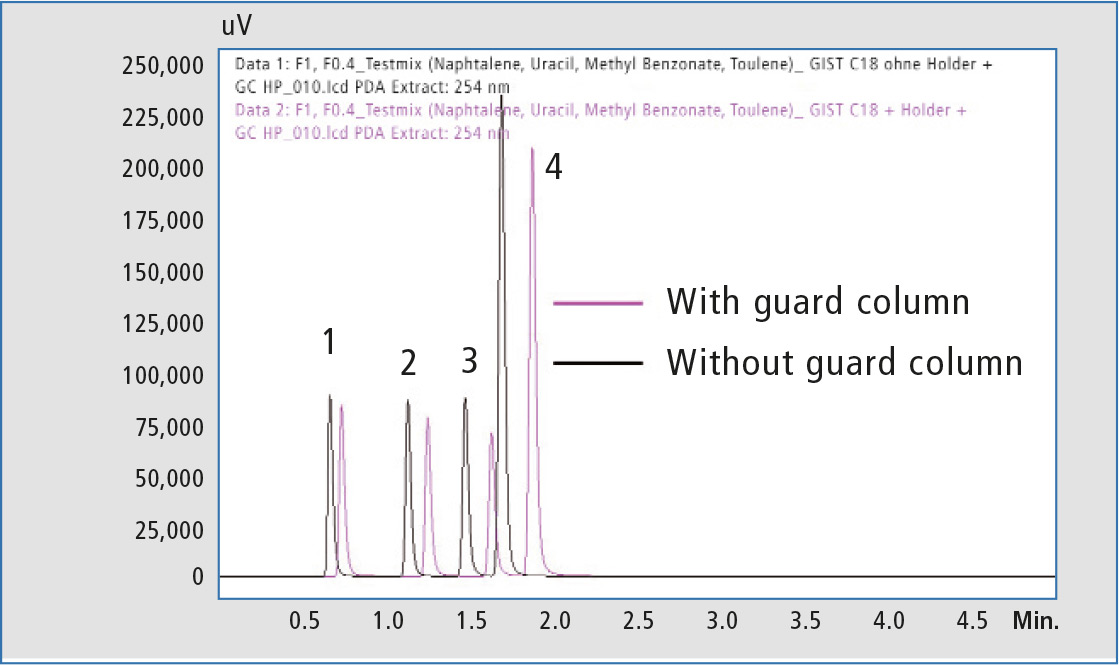 Figure 5: Chromatogram with and without guard column G-series (conventional). Peak 1: uracil, peak 2: methyl benzoate, peak 3: toluene, peak 4: naphthalene
Figure 5: Chromatogram with and without guard column G-series (conventional). Peak 1: uracil, peak 2: methyl benzoate, peak 3: toluene, peak 4: naphthalene
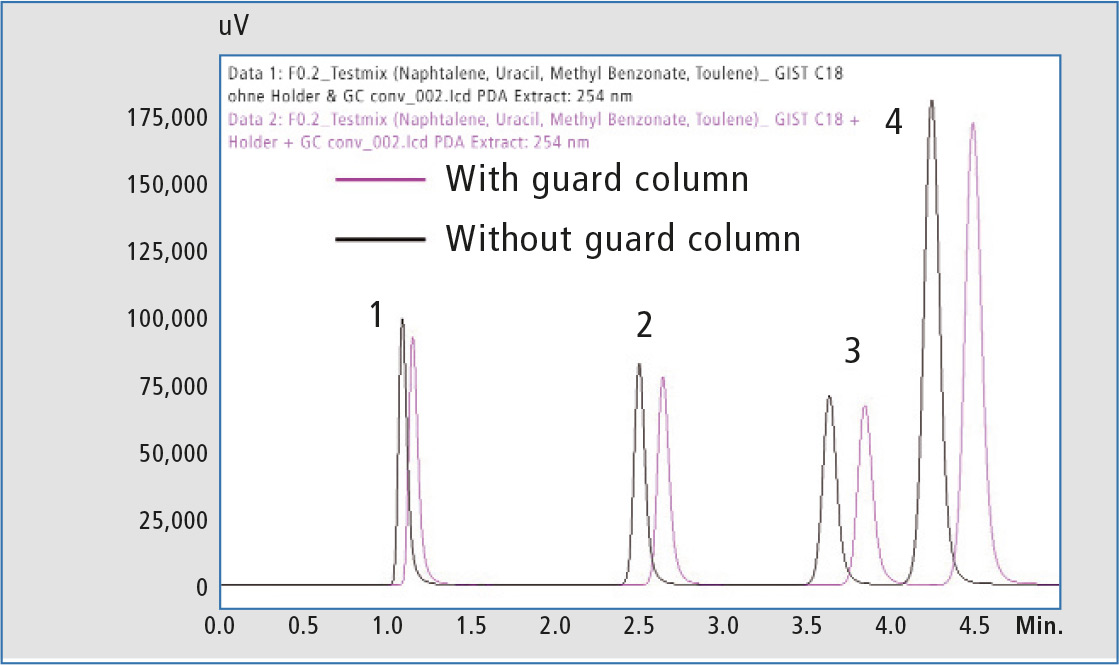 Figure 6: Chromatogram with and without G-series guard column (high-pressure type). Peak 1: uracil, peak 2: methyl benzoate, peak 3: toluene, peak 4: naphthalene
Figure 6: Chromatogram with and without G-series guard column (high-pressure type). Peak 1: uracil, peak 2: methyl benzoate, peak 3: toluene, peak 4: naphthalene
Along with longer retention time, signal intensity also decreases minimally. Measurement values are shown in tables 2 and 3. As expected, the plate number N increases with retention time. This effect is also based on the additional separation performance of the guard column. As a result, the width of the signals also increases slightly. The pressure in the system increases by 12.7 % (conventional type) and 10.5 % (high pressure type) in the columns.
 Table 2: Results of naphthalene on the conventional column of the G-series with corresponding guard column
Table 2: Results of naphthalene on the conventional column of the G-series with corresponding guard column
 Table 3: Results of naphthalene on the high-pressure column of the G-series with corresponding guard column
Table 3: Results of naphthalene on the high-pressure column of the G-series with corresponding guard column
Since the guard column was chosen in the same dimensions as the main column, an additional, narrow separation phase in the system increases the pressure. The retention factor shows no or only slight deviations. This is a very positive effect and shows that the guard column fits very well with the main column.
XR-ODS II columns without matching guard column
In a separate step, XR-ODS II columns were studied with a modified G-series guard column since there are no XR-ODS guard columns available.
Results in figure 7 and in table 4 are similar to those of the G-series. The guard column, retention time, plate number, signal width and pressure increase, whereas the height and area of the signals decrease. As a negative effect, it can be seen that the retention factor k decreases by almost 9 %. Ideally, this would hardly change. Here, it is clear that the guard column does not fit the main column.
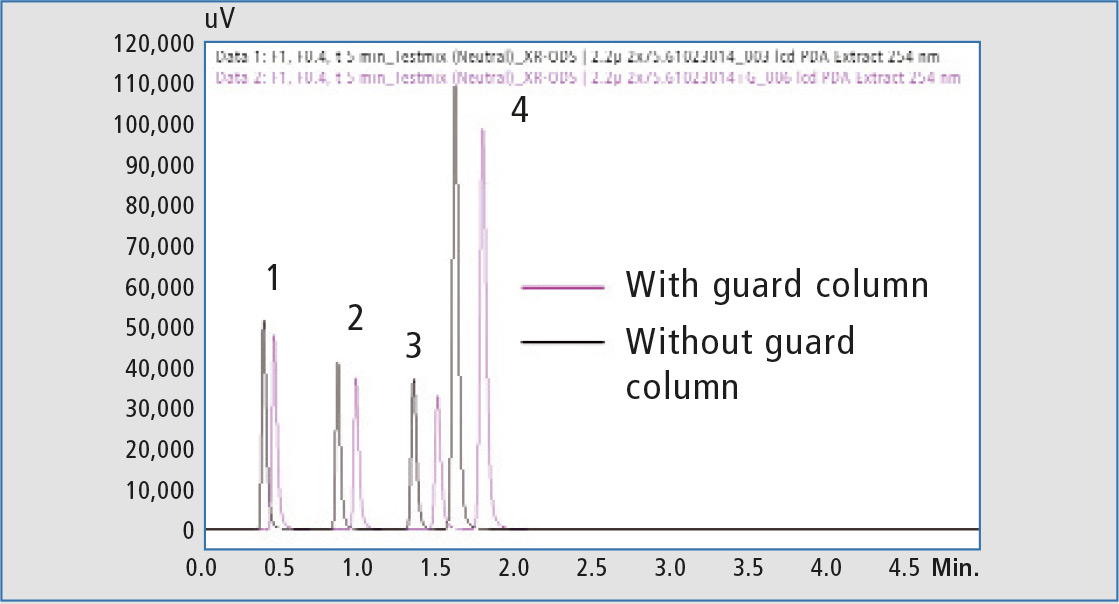 Figure 7: Chromatogram XR ODS II with and without G-series guard column (high-pressure type). Peak 1: uracil, peak 2: methyl benzoate, peak 3: toluene, peak 4: naphthalene
Figure 7: Chromatogram XR ODS II with and without G-series guard column (high-pressure type). Peak 1: uracil, peak 2: methyl benzoate, peak 3: toluene, peak 4: naphthalene
 Table 4: Naphthalene results from the XR-ODS II Column with matched guard column from the G-series
Table 4: Naphthalene results from the XR-ODS II Column with matched guard column from the G-series
Velox core shell columns with and without guard column
Results of Velox core shell columns with and without guard columns are shown in figure 8 and table 5. Here, the best results are compared to the other columns. Retention time and the number of plates increase, but so do signal heights and area when using a guard column. Peak width and retention factor do not change. Also with the Velox column, system pressure increased by 10 % when using the guard column.
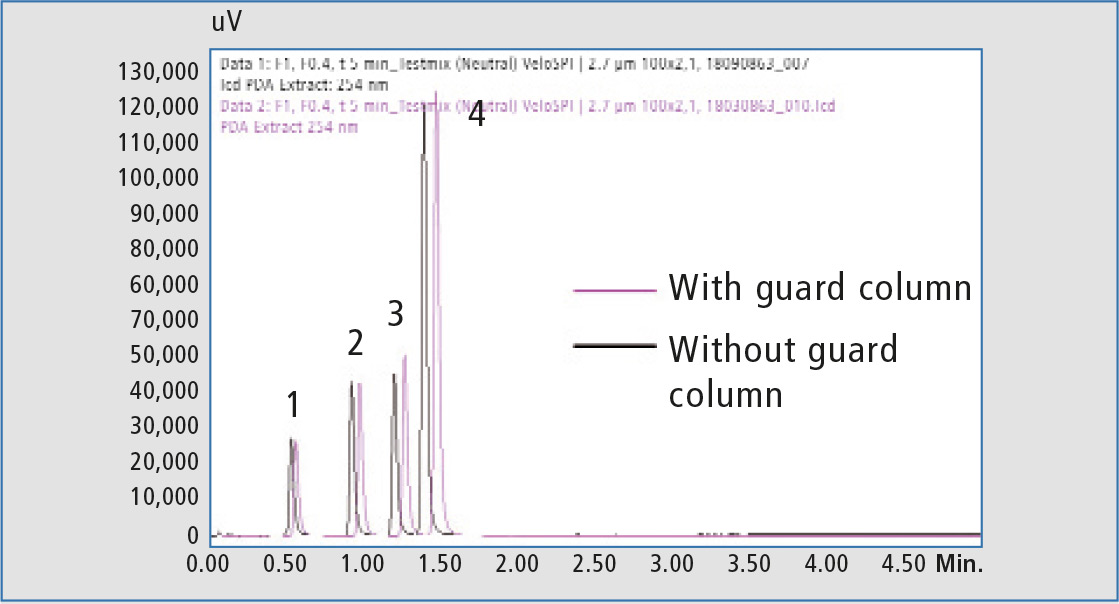 Figure 8: Chromatogram with and without guard column of the Velox series. Peak 1: uracil, peak 2: methyl benzoate, peak 3: toluene, peak 4: naphthalene.
Figure 8: Chromatogram with and without guard column of the Velox series. Peak 1: uracil, peak 2: methyl benzoate, peak 3: toluene, peak 4: naphthalene.
 Table 5: Naphthalene results on Velox Core Shell column with corresponding guard column
Table 5: Naphthalene results on Velox Core Shell column with corresponding guard column
Overall, the results show that guard columns have little effect on analytical measurement and may even change many parameters in a positive sense. The system pressure should always be well monitored when using a guard column.
Conclusion
A guard column protects the expensive analytical column by capturing contaminants or particles. It may be replaced regularly, thereby increasing the life of the analytical column. The use of guard columns makes sense if the sample, matrix or eluent contain impurities or substances that react with or clog the column material. The investigations have shown that analytical separation is only minimally influenced by the use of a guard column. The user can therefore (apart from very critical separations) safely apply a guard column to increase the life span of the analytical column and thereby save costs.
Literature
[1] J. W. Dolan, LCGC, Volume 11, Issue 1.
[2] J. W. Dolan, LCGC North America, Volume 32, Issue 12, 2014.